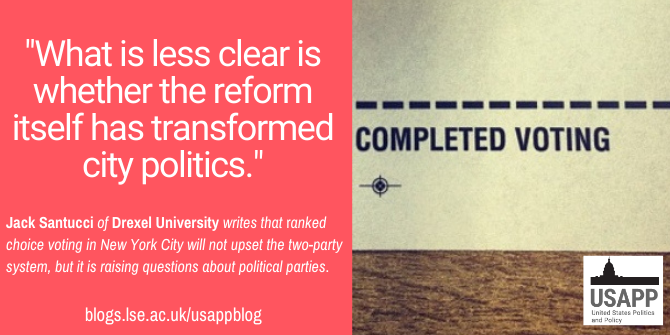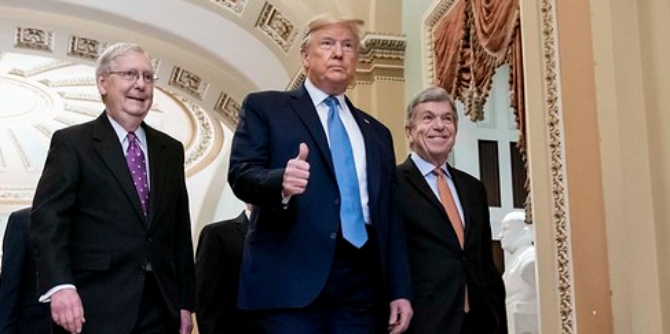 Last month, New York City held primary elections for Mayor and other city government positions. These contests used ranked-choice voting (RCV), whose majoritarian version is gaining popularity in the United States. Jack Santucci questions whether RCV has transformed New York City politics and argues it is part of a wider debate about the role of political parties in America.
Last month, New York City held primary elections for Mayor and other city government positions. These contests used ranked-choice voting (RCV), whose majoritarian version is gaining popularity in the United States. Jack Santucci questions whether RCV has transformed New York City politics and argues it is part of a wider debate about the role of political parties in America.
New York City used ranked-choice voting (RCV) in its nominating primaries for Mayor and other offices last month. Commentators have declared it a success: for producing a Black mayoral nominee, dispelling worries about voter confusion, and reducing the share of men who will run for city council as Democrats this November. The reform increased participation in down-ballot races.
What is less clear is whether the reform itself has transformed city politics. Nor has it contributed to advocates’ main goal, which is moving the United States toward more than two parties. Despite recent history with multiparty competition, New York’s RCV system is not built to channel that. Instead, some advocates want to go in the direction of no parties at all.
How ranked-choice voting came to New York City
By RCV, I mean the ‘single-winner form,’ otherwise known as ‘instant runoff’ or the Alternative Vote, which is different from the single transferable vote (a.k.a., ‘proportional RCV‘) and the block-preferential system.
In ranked-choice voting (as I use the term here), the voter ranks candidates in order of preference, and first-choice votes are counted. If no candidate has a majority, the trailing candidate is eliminated, and ballots in their pile flow to next-ranked picks. The process repeats until some person has a majority of continuing ballots. Typically, in the US, RCV replaces first-past-the-post or runoff elections.
New York City now uses RCV for primaries and special elections for three citywide offices, five borough presidencies, and 51 seats in its city council. This first round of primaries and specials follows a 2019 referendum, initiated by city government, in which 74 percent of over 796,000 voters agreed to adopt the system. The purpose was to eliminate primary runoffs (triggered if the first-round leader did not meet 40 percent), which had been in place since 1969.
Politics transformed?
Reformers have claimed a victory on two fronts: bringing more racial and gender diversity to city council, then giving candidates new incentives to appeal broadly.
One key question is whether RCV changes candidate strategy. An emerging metric is the frequency of come-from-behind (CFB) winners. A winner ‘comes from behind’ when transfers lead to the defeat of the leader in first-choice votes. A CFB indicates coalition-building distinct from what we see under plurality voting.
Results are now certified, with three CFB winners. [NOTE: There was one CFB winner at time of publication, based on results then certified by the Board of Elections.] This is consistent with the rate from the larger set of modern RCV elections. The big result might have been Kathryn Garcia (D) beating first-choice leader Eric Adams (R to D) for the mayoral nomination. That did not happen.
On the diversity front, we should acknowledge that 39 of 51 council seats were subject to term limits. This is not to rule out RCV as a factor. The point is that there may be others. Finally, an open question is whether some third party or independent will enter November’s general election.

“Absentee ballot, submitted” by kaythaney is licensed under CC BY 2.0
New York City RCV is choice within parties — not among them
New York City continues the US pattern of not using RCV to structure choice among parties. Rather, the trend is to rank choices within or in spite of parties. British readers may be familiar with London’s ‘supplementary vote’ (SV) system, used to pick the Mayor. This is different from New York City RCV. Both systems restrict the number of choices a voter may rank — two in London, five in New York City. But the bigger difference is that, in London, parties control use of their labels and tend to nominate one candidate each. Therefore, RCV in London involves choice among parties.
New York City RCV offers choice within but not among parties (except in special elections). This is because the system is used at the primary (or nominating) stage, ahead of the general election. Such uses also can be found in Virginia, Texas, and five states’ 2020 Democratic presidential primaries.
In Maine, RCV combines with state and federal primaries, as well as federal general elections. However, voters may have had choice among gubernatorial parties on their minds when they voted to adopt the system — first in 2016, then again in 2018, to overturn an adverse action by the state legislature. The going interpretation of the state constitution prohibits use for gubernatorial general elections.
Why would power brokers (such as the New York City charter commission) opt against choice among parties? One reason is technical. Under the state’s ballot-fusion rules, multiple parties can nominate the same candidate, who then appears on multiple ballot lines (one for each party). This type of ‘disaggregated fusion’ complicates RCV ballot design — versus what New York City had under ‘proportional RCV’ from 1937-45. In that ‘aggregated fusion’ system, there was one candidate per ballot line.
But the bigger reason for avoiding choice-among-parties is political. Incumbent parties tend not to want to make life easier for more parties — even though choice-among-parties RCV is a boon to the majors. Easier, from a certain perspective, is to create more choice among candidates while preserving (or erecting) barriers to smaller and/or new parties.
Enter RCV in spite of parties
RCV’s newer backers have not shown much interest in multi-party politics. Rather, they prefer a version that gets rid of nominations altogether. Already, there are calls to switch New York City to the ‘Alaska model’ — and a constituency for doing so. This replaces nominations with a plurality winnowing round, then advances four or five candidates to an RCV second round. Final Five Voting, as this is known, is increasingly popular in center-right circles. Even conservative Sen. Tom Cotton (R-AR) feels threatened.
We can debate the extent to which the ‘Alaska model’ is nonpartisan. Party labels will appear on ballots, except that there will be more candidates from the major parties. Parties will not disappear, as both sides of a different debate acknowledge: whether to have any reform at all. And voters may refuse to rank a candidate from the other party, casting doubt on the Alaska system’s ‘moderating potential.’
But one thing seems certain going forward. RCV is caught up in the fight over having parties, period. And it is a fight that people fight about having.
Please read our comments policy before commenting.
Note: This article gives the views of the author, and not the position of USAPP– American Politics and Policy, nor of the London School of Economics.
Shortened URL for this post: https://bit.ly/3hVGK5W
About the authors
 Jack Santucci – Drexel University
Jack Santucci – Drexel University
Jack Santucci is Assistant Teaching Professor of Politics at Drexel University, focusing on party change and electoral systems in the United States.







1 Comments